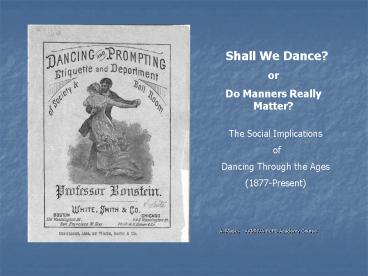SHALL WE DANCE PowerPoint PPT Presentation
1 / 20
Title: SHALL WE DANCE
1
Shall We Dance? or Do Manners Really Matter?
The Social Implications of Dancing Through the
Ages (1877-Present)
- A. Meeks - AAMNVA-FCPS Academy Course
2
USII.1 The Student will demonstrate skills for
historical and geographical analysis, including
the ability to
- a) analyze and interpret primary and secondary
source documents to increase understanding of
events and life in the US history from 1877 to
the present. - b) make connections between past and present.
- d) interpret ideas and events from different
historical perspectives - e) evaluate and debate issues orally and in
writing
3
FIRST IMPRESSIONS (Pre-Assessment Activity)
Luigi Satori
- Describe what you see in this picture.
- Describe what you think is the relationship of
the two women? - Describe what you think may have happened?
- Write a caption for this picture that explains
what you feel this picture is about.
4
Mother, My Ruin Is Accomplished!
Illustration from Luigi Satori. Modern Dances
(Collegeville, Indiana St. Joseph's Printing
Office, 1910 GV1741.S3). General Collections.
- The anti-dance literature of the late nineteenth
and early twentieth centuries was aimed
particularly at women, who were considered at the
time to be especially weak and therefore
susceptible to their potentially lustful dance
partners. Luigi Satori published a vehement
assault on dancing in his Modern Dances, in which
he equates the waltz with breaking the Sixth
Commandment, forbidding adultery. This
illustration, taken from that volume, shows a
young woman confessing her downfall, presumably
brought about by dancing, to her dismayed mother.
The full text of this work, along with that of
many other dance manuals, is found on the
American Memory Web site An American Ballroom
Companion. - http//memory.loc.gov/ammem/awhhtml/awmusic8/
special_dance.html
5
Shall We Dance?
- Review the set of photos and select one. For more
photos, go to the Library of Congress, Prints
Photos Collection. - Research the social and dance-etiquette
requirements using the Library of Congress
Dance Instruction Manuals collection. - Based on your findings, write a brief, in-class
essay explaining how the photo supports or
opposes Satoris comments as well as those found
in the dance manuals. - Choose a popular, current dance-style, and write
a dance manual.
6
The Ballroom, - Salute Partners (1902)
7
The Ballroom, - The Waltz(1902)
8
A Ballroom Tragedy American Mutoscope and
Biograph Company. (1905).
9
"Her step was as light as the marble fawn,
dancing the Marble Waltz" (1907)
10
List of Resources
- The following is a sample of dance manuals that
will be helpful in your research of dance
attitudes and etiquette. The links are provided
for ease of access.
11
Library of Congress Resources
http//memory.loc.gov/ammem/dihtml/dihome.html
12
How to Dance the Tango, Hesitation Waltz and
Other Popular Dances. (1914) This pamphlet on
the tango, claimed by its author to have been
"shorn of crudities which caused it to be
criticized," describes a variety of steps and
step combinations. http//memory.loc.gov/cgi-bin/q
uery/r?ammem/musdibib_at_field(NUMBER_at_od1(musdi155
))
13
Bregeiro Rio Brazilian Maxixe Tango
Bresiliene. (1914) http//memory.loc.gov/cgi-bin
/query/r?ammem/dukesm_at_field(DOCID_at_lit(ncdhasm.a6
021))
14
At the Million Dollar Tango Ball.
(1914) http//memory.loc.gov/cgi-bin/query/r?amme
m/dukesm_at_field(DOCID_at_lit(ncdhasm.a0077))
15
THE TANGO and OTHER UP-to-DATE DANCES a
practical guide to all the latest dances, tango,
one step, innovation, hesitation, etc., described
step by step by J. S. Hopkins illustrated with
photographs posed by Mr. and Mrs. Vernon Castle,
Joseph C. Smith ... and many other famous
dancers. http//memory.loc.gov/cgi-bin/query/r?am
mem/musdibib_at_field(NUMBER_at_od1(musdi097))
16
The Modern Dances, how to dance them, by Caroline
Walker complete instructions for learning the
tango, or one step, the Castle walk, the walking
Boston, the hesitation waltz, the dream waltz,
the Argentine tango. 3d ed.Chicago, Saul
Brothers, 1914. http//memory.loc.gov/cgi-bin/qu
ery/r?ammem/musdibib_at_field(NUMBER_at_od1(musdi161)
)
17
Tango and Other Dances
- The tango and the new dances for ballroom and
home, by Maurice pseud. ... illustrated with
photographs and diagrams. All steps described so
plainly anyone can readily learn them. (Chicago,
Laird Lee, Inc. c1914) - http//memory.loc.gov/cgi-bin/query/r?ammem/musdib
ib_at_field(NUMBER_at_od1(musdi239))
18
Ball-Room Dancing Handbooks
- Handbook of ball-room dancing, by
Paymaster-Commander A. M. Cree, R.N., with an
introduction by George Grossmith illustrated
with diagrams. (London, John Lane New York, John
Lane Co., 1920.) - http//memory.loc.gov/cgi-bin/query/r?ammem/m
usdibib_at_field(NUMBER_at_od1(musdi051))
19
American Memory Resources
- Antidance Literature - http//memory.loc.gov/ammem
/dihtml/diessay8.html - Dance Religious Aspects http//memory.loc.gov/c
gi-bin/query/r?ammem/musdibib_at_field(NUMBER_at_od1(m
usdi208)) - Etiquette - http//memory.loc.gov/cgi-bin/query/r?
ammem/musdibib_at_FIELD(SUBJ_at_band(Etiquette.))he
adingEtiquette - Nineteenth Century Social Dance -
http//memory.loc.gov/ammem/dihtml/diessay6.html - Ragtime Dance - http//memory.loc.gov/ammem/dihtml
/diessay7.html
20
Has Dancing Really Changed? Has the social
perception or attitude towards dancing changed
regarding contemporary styles of dancing?
- Using resources provided from the LC Memory
Collection. Research the social and
dance-etiquette requirements for the late 19th
and early 20th centuries. - THEN
- Using current articles and personal experience,
write a brief essay comparing the social aspects
of the previous era to todays culture. - OR
- Write a brief article describing your findings
convincing your readers that the perception of
dancing styles has or has not changed through the
ages.

